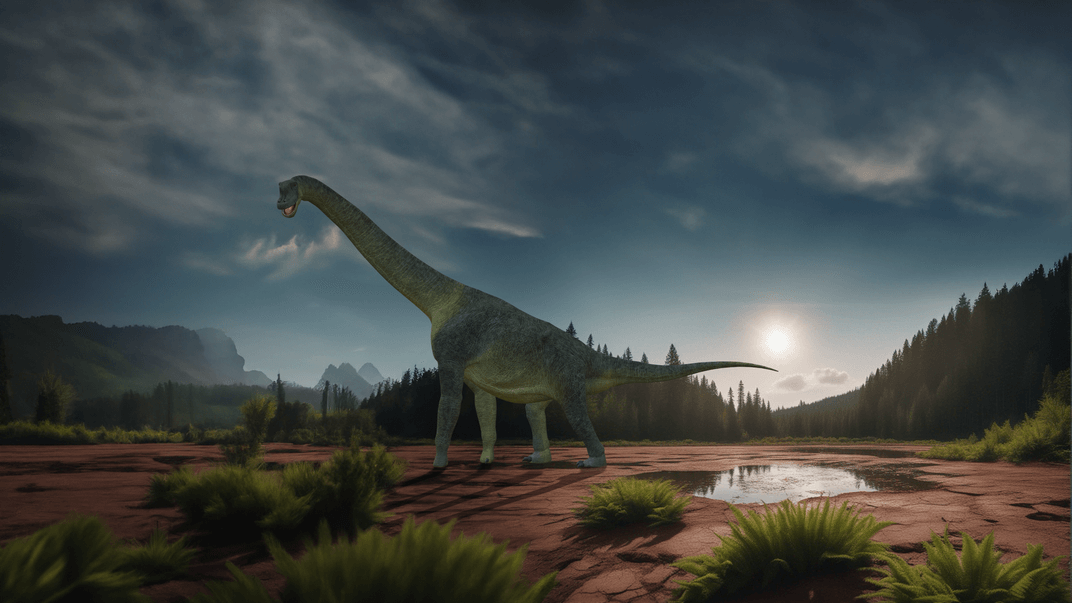
New ‘Giant’ Species of Long-Necked Dinosaur Discovered In Spain
The prehistoric creature, named Garumbatitan morellensis, may help palaeontologists unravel the evolution of the plant-eating sauropods
By: Sarah Kuta | Smithsonian
Around 122 million years ago, large, long-necked dinosaurs tramped around the land that is present-day Spain. Palaeontologists recently unearthed the fossilized remains of some of these massive creatures, which they’ve identified as a new species.
Named Garumbatitan morellensis, the newly discovered behemoths could help researchers understand the evolution of sauropods, a group of four-legged, plant-eating dinosaurs with long necks and tails.
“This new sauropod is one of the best-preserved sauropods found in the Lower Cretaceous of Europe, which provides us key information about the evolutionary history of the group in this geographic domain,” Pedro Mocho, a palaeontologist at the University of Lisbon, tells Newsweek’s Aristos Georgiou.
Mocho and other researchers shared their findings in a new paper published last week in the Zoological Journal of the Linnean Society.
Today we published a new study in @ZoolJLinnSoc conducted from the @IdlLuiz (@FC_UL @ULisboa_ ) and Grupo de Biología Evolutiva @UNED, establishing a new dinosaurian species, the sauropod Garumbatitan morellensis! The link is here: https://t.co/Tm1GS7asZT#paleontology #geology pic.twitter.com/dtckakq16R
— Pedro Mocho 🏳️🌈🦕 (@PD_Mocho) September 28, 2023
G. morellensis is a member of a sauropod subgroup called Somphospondyli, which roamed far and wide throughout the Cretaceous period. Palaeontologists have found fossils of somphospondylans all over the world, so they’ve had a hard time figuring out where the creatures may have originated.
Octopuses Were Around Before Dinosaurs: The Oldest Known Octopus Fossil Is 330 Million-Year-Old
But the discovery of G. morellensis in Spain adds another pin to the map. And, since G. morellensis is a “primitive” member of the group, scientists say it’s possible that somphospondylans originally hailed from Europe, then fanned out to what is now Asia, North America and Africa, writes Live Science’s Harry Baker.
A team of Spanish and Portuguese palaeontologist’s uncovered G. morellensis’ remains while working at the Sant Antoni de la Vespa fossil site between 2005 and 2008.
The region, which is located near the city of Morella in eastern Spain, has produced numerous dinosaur fossils. But researchers say many more remain buried, and further excavations could help reveal even more about its past.
“Here in this region, we say that ‘tota pedra fa paret’—every stone makes a wall—and this stone is helping to build the paleontological wall, because it is big,” says study co-author José Miguel Gasulla, a palaeontologist at Spain’s National University of Distance Education (UNED), to El País’ María Pitarch.
They discovered vertebrae, leg bones and foot bones, which they believe belonged to at least three separate G. morellensis individuals. These sets of remains likely date to the Early Cretaceous period, which spanned roughly 145 million to 100.5 million years ago.
The foot bones were especially noteworthy, as palaeontologists unearthed “two almost complete and articulated feet,” which is “particularly rare in the geological record,” Mocho says in a statement.

They can’t tell exactly how large G. morellensis could have grown. But they do know from the creatures’ bones that it was massive: Some of the vertebrae they discovered were 3.3 feet wide, and one of the femurs was 6.6 feet long. According to their estimates, these dinosaurs may have been 33 feet tall and likely ate between 66 and 88 pounds of vegetation each day, per El País.
The dinosaur’s name is also a nod to its colossal size, as well as the geography of the region, according to the statement. Garumbatitan means “the giant of the Garumba” and refers to Muela de la Garumba, a mountain peak in the Els Ports region of Spain near where the fossils were discovered. Morellensis, meanwhile, is a reference to the nearby city of Morella.
* * *
NEXT UP!
Scientists Find Out If A Lashing Dinosaur Tail Could Generate A Sonic Boom
Every once in a while, scientists embark on a study to test some weird and wacky hypothesis that makes you wonder why. But let’s indulge them; it can be fun
A new study from a team of palaeontologists and aerospace engineers has simulated a dinosaur‘s tail as it lashes about, all to see whether long-necked sauropods could whip their appendages faster than the speed of sound – quick enough to produce the crack of a small, supersonic boom.
Previous research has suggested the dinos could, if their tails had a bullwhip-like structure adding length. If that were true, these herbivorous dinosaurs might have used their tails to defend themselves against predators or nosy neighbours.
* * *
READ MORE: A Dinosaur Killed On The Day of The Fatal Asteroid May Have Been Discovered
Read more on Palaeontology: Giant ‘Death Shadow’ Dinosaur Found In Argentina Is Largest Megaraptor On Record
Liked it? Take a second to support Collective Spark.
We’d love to hear from you! If you have a comment about this article or if you have a tip for a future Collective Spark Story please let us know below in the comment section.
